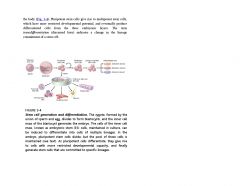![]()
![]()
![]()
Use LEFT and RIGHT arrow keys to navigate between flashcards;
Use UP and DOWN arrow keys to flip the card;
H to show hint;
A reads text to speech;
16 Cards in this Set
- Front
- Back
|
Quiescent Tissues
|
Low levels of replication but can undergo rapid division in response to stimuli and thus capable of reconstituting the tissue of origin (liver)
|
|
|
Continuously Diving Tissue
|
Proliferate throughout life (epithelum); mature cells are derived from stem cells
|
|
|
Nondividing Tissues
|
Cells that have left the cell cycle and cannot undergo mitotic division in post natal life; Neurons, skeletal, and cardiac muscle cells
|
|
|
Obligatory Asymmetric Replication
|
Two stem cell divisions; one enters differentiation pathway and one retains its self renewing capacity
|
|
|
Stochastic Differentiation
|
Stem cell divisions generate either two self renewing cells or two cells that differentiate; these two lineages balance out over time
|
|

Pluripotent stem cells
|
Generate all tissues of the human body
|
|

Multipotent Stem Cells
|
More restricted than pluripotent, but produce the three embryonic layers
|
|
|
Niche Cells
|
Generate or transmit stimuli that regulate stem cell self-renewal and the gneration of progeny cells
|
|
|
Embryonic Stem cells
|
The inner mass of blastocysts in early embryonic development contain pluriupotent stem cells known as embryonic stem cells
|
|
|
iPS cells
|
Reprogrammed human fibroblast cells (Oct3/4, Sox2, c-myc, Klf4 and homeobox protein Nanog acts to prevent differentiation)
May become a source of cells for patient specific stem cell therapy wo the involvement of nuclear transfer into oocytes |
|
|
where are adult (somatic) stem cells located?
|
Tissues that continuously divide; bone marrow, skin, lining of the GI tract
|
|
|
Skin Stem Cells
|
Bulge stem cells
Located in the bulge area of the hair follicle, in sebaceous glands and in the lower layer of the epidermis |
|
|
Intestine Stem Cells
|
Crypt stem cells
Small intestine stem cells located near the base of a crypt, above Paneth cells |
|
|
Liver Stem Cells
|
Oval Cells
Located in the canals of Hering (structures that connect bile ductules) with parenchymal hepatocytes |
|
|
Corneal Stem Cells
|
Located in the limbus region, between the conjunctiva and the cornea
|
|
|
Skeletal stem cells
|
Myocytes do not divide after injury; growth/regeneration occur due to replication of satellite cells
|

